Although they may not have thought about it, many businesses know excellent people who could act as brand ambassadors. They have past positive experiences of the brand and will generally be happy to recount these experiences for the world to hear. Businesses hire brand ambassadors to deliver positive messages about their brand. Usually, these people are eagerly willing to participate. They may not be influencers, as such, but each will have some audience whose opinion they can influence.
Modern consumers are cynical about traditional advertising campaigns. Indeed, anything like an old-style ad turns off many people, particularly those belonging to Generation Z. If trustworthy brand ambassadors sound enthusiastic about your brand, however, even the most hardened cynics might take notice. Working with satisfied customers can be far more successful for a brand than working with actors or people who are simply after an easy way to earn money.
Setting up a brand ambassador program will require some thought and planning, however. In this post, we look at some things you will have to consider and go through how you can set up your brand ambassador program to make it as effective as possible.
How to Set up a Brand Ambassador Program:
- What is a Brand Ambassador Program?
- Why Your Business Should Have a Brand Ambassador Program
- How do You Find Brand Ambassadors?
- Set Goals For Your Brand Ambassador Program
- What Types of People Do You Want as Brand Ambassadors?
- Identify and Reach Out to Potential Brand Ambassadors
- Set Guidelines for Your Brand Ambassadors
- Work With Your Brand Ambassadors
- Analyze How Your Brand Ambassadors Perform
What is a Brand Ambassador Program?
Brand ambassadors are those people willing to speak out positively about your brand. They may be satisfied customers, supporters, or even employees. If you operate a brand ambassador program, this formalizes the process and sets up a system where you can pay selected people to act as brand ambassadors.
You can encourage your brand ambassadors to make social posts promoting your business, perhaps showing off their latest purchases of your products or raving about your outstanding service.
Although they will clearly enjoy any payment, brand ambassadors usually have a genuine liking for your business. Their social posts reflect a real pleasure for the company, its products, services, and activities.
When a company enters a brand ambassador program, it actively seeks its brand's fans to undertake promotion on its behalf. In most cases, companies invite suitable people to be their brand ambassadors.
Brands tend to have longer relationships with brand ambassadors than they do influencers. This is because your brand ambassadors genuinely care about your company and product. And they often are happy to promote it even without any formal financial arrangement. However, influencers will generally want more formal agreements and may work with other companies who offer a better deal.
Why Your Business Should Have a Brand Ambassador Program
One advantage of using a brand ambassador program is that your ambassadors can preach your company's strengths without sounding like a paid advertisement. They typically don't talk in sales-talk. They sound natural because they genuinely believe what they say about the brand on social media.
Companies in virtually every sector work with brand ambassadors. They are particularly prevalent in eCommerce. You should definitely consider using brand ambassadors when you don't have strong social accounts yourself.
You may have unofficially been working with so-called brand ambassadors for some time. A brand ambassador program formalizes these arrangements. It also helps ensure that you have the best people promoting your products for you.
How do You Find Brand Ambassadors?

Source: enjoyleggings.com
You could begin your search for suitable brand ambassadors by examining people who already interact with your brand on social media. You might not have many followers on your social accounts, but do any of them stand out for their level of engagement? If you have created any hashtags for your brand, examine their usage using your analytics to see if anybody regularly uses the hashtags and shares your posts.
If you subscribe to any social listening software, you can use it to examine your brand mentions. Do you see people who regularly report and praise the activities of your brand? These tools make it simple to find any @mentions of your business or use of your branded hashtags.
It could also be worthwhile checking your customer records to determine who your best customers are. Who comes back regularly for repeat visits? Of course, this depends very much on the nature and scale of your business. For instance, a supermarket would have many repeat customers who return each week out of necessity, rather than because of any brand loyalty.
Some brands prefer to take a more proactive approach. They set up a brand ambassador program and then ask people to self-identify and apply for membership in the program. For example, Enjoy Leggings sells leggings by subscription. When you sign up for Enjoy Leggings, you receive a new pair of fun and fashionable leggings every month, shipped straight to your door. They ask for people to apply to their brand ambassador program to spread the word about the company online. In return, they offer free leggings, sneak peeks at new products, and exposure through the company's Instagram and Facebook pages through re-posts.
Set Goals For Your Brand Ambassador Program
As with virtually any marketing activity, you should set clear goals when setting up your brand ambassador program. You shouldn't set one up simply because you have read that it's a good idea. You need a clear reason to have such a program.
You will have to devote time, energy, and money to your brand ambassador program, so you need to justify that investment with clear reasons for the program to exist. In most cases, your goals will relate to brand awareness rather than direct sales.
You should ensure that your goals are clear and measurable. If you're focusing on brand awareness, you will want to include some tangible statistics in your goal. For example, you might aim your brand ambassadors to increase your brand mentions by 20% each month. You might have an aim of them increasing the number of followers to your official company social accounts by 50% over the next six months, for instance.
If you wish to use your brand ambassadors for more sales-focused purposes, you will need to have a way to measure the additional sales that come about as the result of your brand ambassadors' efforts. This means you will need to use clear tracking links tied to specific campaigns.
What Types of People Do You Want as Brand Ambassadors?
Just as you may have sat down and identified your ideal customer, perhaps creating customer personas, you need to establish the type of person who would make your perfect brand ambassador. Of course, not every brand ambassador will match your ideal, but it will give you an idea of the person you hope to attract. It also may help you know the types of people you might like to avoid, particularly when you have opened your brand ambassador program up to applicants.
Ideally, you want people to be genuinely eager customers. You want to work with people who actually like your product and don't just want to participate in the hope of a free product, or perhaps even payment.
Also, your brand ambassadors have to be of value to you. Sure they won't have the support base of influencers; however, they have to have reasonably popular social accounts with which they frequently engage.
According to Repsly, "ideally, the candidate is a tastemaker in their communities, and should plan to use already established networks and relationships to market the brand via word-of-mouth marketing tactics … on top of that, a brand ambassador will also represent her company at specific events, where she may perform product demonstrations or give away sample products." Repsly adds, "a candidate for the position of brand ambassador should be an enthusiastic, outgoing individual with a considerable social media presence and a medium to large-sized network. He or she presumably is already familiar with and endorses the brand being represented."
Ideally, you will want to ensure that your brand ambassadors have similar values to your organization.
Identify and Reach Out to Potential Brand Ambassadors

Source: medium.com
If you have established a system where people apply to become brand ambassadors, you will need to examine each applicant's merits. Depending on how you intend to reward your brand ambassadors, you might have a limit on the number of people with whom you wish to work.
You will need to identify suitable applicants and add to them potential brand ambassadors you have selected yourself. At this point, it would help if you reach out to them to establish their willingness to act on your behalf. You need to ensure that they understand what you are promising them in return for their social posting.
Firms are generally much more selective about who they accept as brand ambassadors than for other programs, such as affiliates or referral programs.
Set Guidelines for Your Brand Ambassadors
Ideally, you should create some form of a style guide for your brand ambassadors. You can include all your expectations of them in this guide.
At the very least, you will want to ensure that they leave a positive impression of your brand (which they should naturally do if you have selected suitable people as your brand ambassadors).
While you probably won't need to be too prescriptive with your brand ambassadors, you will want to give them guidelines of the products and campaigns you would like them to highlight. You should also include your brand and campaign hashtags and explain the type of posts suitable for each hashtag.
You should probably also explain how you want your brand ambassadors to handle mentions of your competitors. You don't want them blatantly trashing your competitors while representing you, are making any potentially legally liable statements.
Work With Your Brand Ambassadors
You generally won't have to micromanage your brand ambassadors. As long as you ensure your guidelines are appropriate and notify your brand ambassadors of any changes you wish to make. For example, if you intend to release a new product, you might send free samples to your brand ambassadors, knowing that they will likely review and make posts relating to them.
You will probably need to spend some time onboarding them at the start of your relationship. By doing this, you can ensure that they understand your guidelines and expectations.
However, don't leave your brand ambassadors hanging once they are part of your program. Send them regular updates so that they feel involved and that you aren't taking advantage of them.
You shouldn't get too involved with the actual messages they share. The whole point of having a brand ambassador is that they are authentically posting about how they like your product. You certainly don't want them sharing official ads or talking in "corporate speak."
Analyze How Your Brand Ambassadors Perform
In most cases, working with brand ambassadors will have a cost, whether it is free products or cash payments. Therefore, you need to ensure that your relationships are worth their price. Like all campaigns, you need to use your analytics to establish how successful your campaigns are.
You may remember that the first step of working with brand ambassadors was to set some goals. As your campaign progresses, you need to determine how successful you are at meeting those goals. This is one of the reasons why you need to set clear, measurable goals. You can use these to establish the success or otherwise of a campaign.



